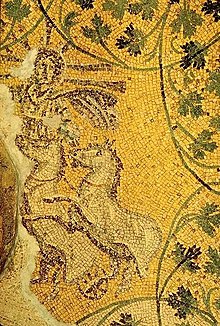| Revision as of 16:23, 26 December 2020 editStarTrekker (talk | contribs)Autopatrolled, Extended confirmed users, New page reviewers174,836 edits →References← Previous edit | Revision as of 13:32, 21 January 2021 edit undoSrich32977 (talk | contribs)Autopatrolled, Extended confirmed users, New page reviewers, Pending changes reviewers, Rollbackers299,998 edits Cleaned up using AutoEdNext edit → | ||
| Line 1: | Line 1: | ||
| {{Short description|Part of the Vatican Necropolis}} | |||
| {{coord|41|54|8|N|12|27|12|E|display=title}} | {{coord|41|54|8|N|12|27|12|E|display=title}} | ||
| ] | ] | ||
| Line 10: | Line 11: | ||
| ==References== | ==References== | ||
| *Beckwith, John 1979. ''Early Christian and Byzantine Art'' (Yale University Press): 19 | * Beckwith, John 1979. ''Early Christian and Byzantine Art'' (Yale University Press): 19 | ||
| *Perler, Othmar 1953, ''Die Mosaiken der Juliergruft im Vatikan'' (Universitätsverlag): |
* Perler, Othmar 1953, ''Die Mosaiken der Juliergruft im Vatikan'' (Universitätsverlag): 34–36 | ||
| *Walsh, John Evangelist. ''The Bones of Saint Peter'' (The Chaucer Press): 15 | * Walsh, John Evangelist. ''The Bones of Saint Peter'' (The Chaucer Press): 15 | ||
| ;Specific | ;Specific | ||
| Line 18: | Line 19: | ||
| ==Further reading== | ==Further reading== | ||
| *], ed., '''', no. 467, 1979, ], New York, {{ISBN|9780870991790}} | * ], ed., '''', no. 467, 1979, ], New York, {{ISBN|9780870991790}} | ||
| {{DEFAULTSORT:Tomb Of The Julii}} | {{DEFAULTSORT:Tomb Of The Julii}} | ||
Revision as of 13:32, 21 January 2021
Part of the Vatican Necropolis41°54′8″N 12°27′12″E / 41.90222°N 12.45333°E / 41.90222; 12.45333

The popularly named "Tomb of the Julii" (Mausoleum "M") survives in the Vatican Necropolis beneath St. Peter's Basilica. The serendipitous discovery near the crypt has a vaulted ceiling bearing a mosaic depicting Helios (Roman Sol Invictus) with an aureole riding in his chariot, within a framing of rinceaux of vine leaves, which are not given their usual pagan Dionysiac reading in this context but are related to the True Vine imagery of Gospel of John 15.1. The mosaic is dated to the late 3rd century to early 4th century. Other mosaics in this tomb depicting Jonah and the whale, the good shepherd carrying a lamb (the kriophoros motif), and fishermen have encouraged its interpretation as a Christian tomb.
This tomb was first discovered in 1574 AD when workmen accidentally broke through the ceiling while conducting some floor alterations in the basilica. The inside was briefly explored and documented before the opening was sealed over once more.
See also
References
- Beckwith, John 1979. Early Christian and Byzantine Art (Yale University Press): 19
- Perler, Othmar 1953, Die Mosaiken der Juliergruft im Vatikan (Universitätsverlag): 34–36
- Walsh, John Evangelist. The Bones of Saint Peter (The Chaucer Press): 15
- Specific
- The Bones of Saint Peter, John Evangelist Walsh 1982
Further reading
- Weitzmann, Kurt, ed., Age of spirituality: late antique and early Christian art, third to seventh century, no. 467, 1979, Metropolitan Museum of Art, New York, ISBN 9780870991790